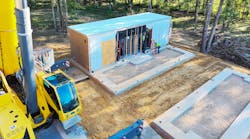MONTE CARLO, Monaco – The connected car will be a driving force in the digital economy, creating a vast business ecosystem and an ocean of data. That’s clearly seen in growth trends at Uber, which served 2 billion trips in 2016, and more than 4 billion trips in 2017. The transportation logistics company is now supporting 15 million trips a day in 600 cities in 78 countries around the world.
That growth has made Uber a major user of data center infrastructure. As Uber scales up, with ambitions of creating markets for new data-intensive business, Dean Nelson is tasked with keeping the bits flowing and the apps running.
“It’s incredible how this opportunity is growing so rapidly,” said Nelson, the Head of Uber Compute. “The vision for the company is to make it simple to do transportation. This has been growing like gangbusters.”
Uber is about to hit a new phase of growth. In a talk Tuesday at Datacloud Europe, Nelson said he is looking for data center providers to work with Uber to deploy new infrastructure. Uber currently operates its data centers in the U.S., using cloud partners to help manage edge data flows from around the globe.
Building Faster, 5 Megawatts at a Time
Tuesday’s presentation was the first time Nelson has spoken publicly about his work at Uber Compute and the growth of Uber’s network. The company has quietly become a significant customer for wholesale data center providers. Uber leased large chunks of “plug-n-play” wholesale space in three major markets during 2015, and is focused on expanding the capacity and geographic reach of its footprint.
To streamline Uber’s expansion, Nelson has developing a “building block” approach, creating a reference architecture for deploying new infrastructure. By using a repeatable design, Nelson is hoping to work closely with providers of wholesale data center space.
“We’ve spent time developing the building blocks so we can expand rapidly around the world,” said Nelson.
Uber has defined a 5 megawatt data center “zone” deployment that will serve as the base unit for the company’s network. Each zone features 10,000 to 15,000 square feet of data center space, leased on a five year term, with a right of first refusal on 5 megawatts of adjacent space. A zone contains 576 racks, divided among standardized groupings of hardware for base compute, storage and machine learning.
That configuration includes some racks using 8 kilowatts of power, and others requiring as much as 40 kW per rack. Nelson, who has serious experience with high density workloads from his tenure running data centers at eBay, says he is agnostic about how those 40 kW racks are cooled. It’s one of many requirements where he’s looking to data center providers to address how Uber’s pod design will work best within their facilities.
“Bake this cake for us,” said Nelson, addressing the providers in the room. “Allow us to make our RFPs simple.”
The Power of Collaboration
By openly laying out his requirements, Nelson is open sourcing a trend that has been going on for some time. Hyperscale companies and cloud computing providers have been working closely with providers to provide specific guidance on their data center requirements, similar to a build-to-suit arrangement.
This approach has helped large hyperscale tenants deploy capacity quickly to keep pace with their meteoric growth.
Uber expects big growth ahead. The company is moving beyond its ride-sharing business to develop new offerings for trucking (Uber Freight), food delivery (Uber Eats), and helping more patents make doctor’s appointments (Uber Health). Uber is actively developing autonomous cars, and even working on flying cars (Uber Elevate).
Even if the flying cars are a few years off, Uber is on track for vigorous growth that will test the industry’s ability to keep pace. Nelson said that he envisions hundreds of zones of Uber infrastructure around the world.
“That’s a lot of investment,” said Nelson. “”With 15 million trips a day, think about the data being generated, and what goes on every second.”
Zones Guide Network Architecture
Uber’s thirst for data center space illustrates the emerging demand from companies in two data-intensive sectors – connected cars and the peer-to-peer “sharing economy.” As these sectors mature, the leading players will generate huge amounts of data, much of which must be managed in real-time systems spanning large geographies.
Uber generates and manages large volumes of data, primarily to support its real-time dispatch system that matches drivers with riders using mobile phones. That requires real-time tracking of drivers in every city, accessing mapping and databases that span a huge global platform.
The architecture shared by Nelson this week employs availability zones, a concept popularized by Amazon Web Services that groups multiple data centers in a geographic region to provide low-latency failover capabilities should one of the facilities experience an outage. Nelson sees this architecture as being critical to both the mission critical nature of Uber’s business – including plans for autonomous cars and drones – as well as the opportunity to ultimately use its network to manage resiliency.
Nelson said Uber currently uses data centers with redundant power and cooling equipment (Tier III) but hopes to one day take advantage of variable resiliency space, which can offer better economics to companies with advanced networks.
About the Author



